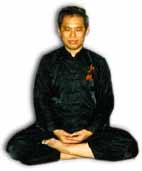CULTIVATING SPIRIT, TRAINING ENERGY AND SITTING MEDITATION

Cultivating Spirit Training Energy
Question
In Sifu’s incredible translation of the Treatise of Zhang San Feng he explains that meditation is an essential part of the cultivation, and SIfu goes on to explain why we don’t emphasise sitting meditation in our school, preferring the expedient means of standing meditation and flowing meditation due to our different aspirations.
I’m curious to know Sifu’s view of how separate meditation practice might have been integrated into Zhang San Feng’s training. Does Sifu have a view, for example, of how long he might have sat in meditation (compared to how much he might have practised Wudang Kungfu), what type or method of meditation he might have practised, and how would this aspect of his spiritual cultivation have contributed to his development and attainment?
Although we have different aspirations, I’m sure many in our school do practice some form of meditation, perhaps sitting on a chair as I do, in addition to our other qigong and Tajiquan practice.
Could Sifu recommend any specific meditation methods that if practised, would complement our Tajiquan training, whether they are the same or different from what he has taught on various Zen courses in recent years? I have a suspicion the answer may mirror some of the ten essentials such as being relaxed and not thinking of anything, but I'd love to hear this from Sifu.
Matthew
Answer
It is significant that in his Treatise Zhang San Feng did not specifically mention sitting meditation (in a lotus or semi-lotus position). By meditation, we mean spiritual cultivation. He emphasized the cultivation of energy and spirit.
However, sitting meditation was a very important part of Zhang San Feng’s cultivation. There was no mention of how much time Zhang San Feng spent in sitting meditation, but I believe he would have spent more time in sitting meditation than in his kungfu practice. That was the norm of spiritual cultivators. Monks at the Shaolin Monastery, including kungfu monks, spent more time in sitting meditation than in anything else. After all, sitting meditation was the paramount path to the highest attainment of spiritual cultivation, called variously as attaining Buddhahood, merging with the Tao, or returning to God the Holy Spirit.
Our aim is not to attain the highest spiritual cultivation. There are five aims in Shaolin Wahnam:
- To be healthy.
- To have vitality.
- To have longevity.
- To have mental clarity.
- To have spiritual joys, like being peaceful and happy.
There are two reasons why I don’t teach sitting meditation.
My practice of sitting meditation has made me very powerful, so powerful that I don’t want to carry this burden. I do not want others to carry this burden too.
This was the immediate reason. I taught sitting meditation every night at Shaolin Wahnam Association, the for-runner of our Shaolin Wahnam Institute. But after discovering this tremendously powerful burden, I stopped teaching it.
The second reason was, and still is, that we could attain in standing meditation what serious spiritual cultivators hoped to attain in sitting meditation. Benefits of meditation, in any form, range from being relaxed as the basic, to merging with transcendental Supreme Reality as the highest, with all other benefits in between.
We can attain all benefits in standing meditation, except perhaps the powerful burden I mentioned earlier. Standing meditation is safer and faster.
Meditation is not just sitting crossed legged or in a lotus position. It is the training of mind, or spirit. There are four positions for meditation, namely standing, sitting, moving and lying down.
These four positions were not mentioned by Zhang San Feng in his Treatise. But he emphasized that cultivation of energy and spirit was very important. Anyone who misses cultivation of energy and spirit would have missed his teaching. In Zhang San Feng’s training, every movement involved cultivation of energy and spirit. We have benefited from Zhang San Feng’s teaching. Every movement in any of our arts is cultivation of energy and spirit.
I spent more time in sitting meditation than in practicing Wudang Kungfu. But if we are to compare the time in practicing kungfu, especially Shaolin Kungfu, I would have spent less time.
I spent a lot of time in sitting meditation, but I also spent a lot of time in standing meditation, like standing at the Wuji Stance before and after each practice. Spiritual cultivation has contributed very much to my development and attainment.
I am peaceful and happy, not just during meditation, but also at all times. Many people have been kind to mention that I am wise and courageous, two of the qualities we aspire to cultivate in our school. In my younger days, I sparred with many people, including masters and professionals, and I remained undefeated.
Every time we practice our arts, we perform triple-cultivation, i.e. we cultivate our body, our energy and our mind or spirit. It is not just in formal practice, like meditating on a chair or performing Taijiquan, but also in our daily life that we develop our desirable qualities. When we walk along a street, for example, our mind is free of irrelevant thoughts, or when we carry on our daily activities we do so with vitality.
Taijiquan as taught by Zhang San Feng is triple-cultivation, i.e. cultivation of energy and spirit besides cultivating the body. A useful piece of advice is to make every movement a masterpiece.
The answer here indeed mirrors all the Ten Essentials of Taijiquan. During the time of Zhang San Feng, it was called Shaolin Kungfu. As Shaolin Kungfu is the best martial art, these Ten Essentials are not only excellent for any martial art but excellent for daily living.

Sitting Meditation
The questions and answers are reproduced from the thread Questions to Grandmaster on Wudang Kungfu/Taijiquan & Zhang San Feng in the Shaolin Wahnam Discussion Forum.
LINKS
